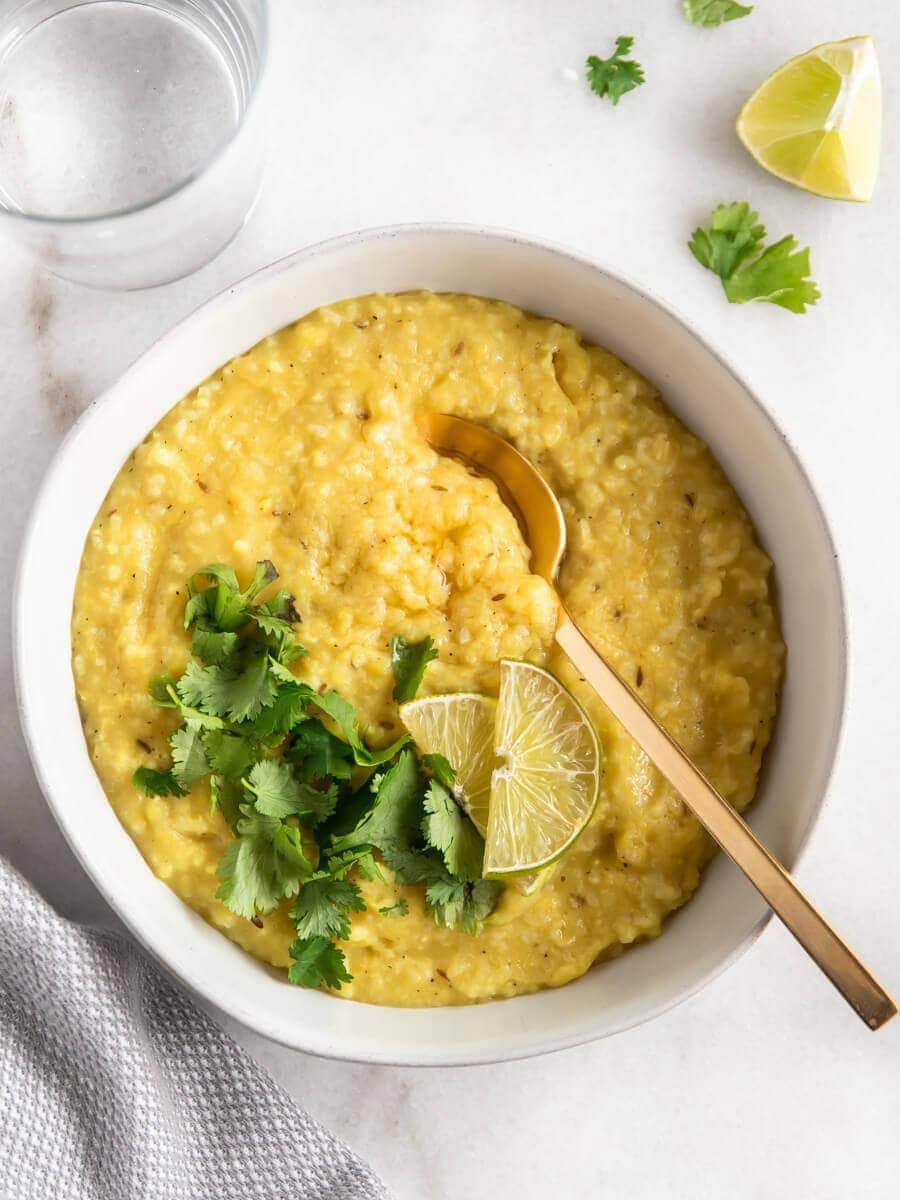Simple, comforting, healing lentil and rice vegetarian stew with healthy, whole ingredients.
Have you been looking to make kitchari and didn’t know how or what to do? Were you intimidated by some recipes? Did you buy an expensive kit? This simple, comforting healing recipe is here to solve your issues and help you feel your absolute best! This is the easiest comforting and nourishing one-pot wonder.
Description
We grew up eating kichadi almost every Sunday night. For years, I thought it was because we had eaten through everything fresh in the fridge and our poor mom was exhausted. She probably was, indeed with three kids and a full-time job. In reality, my mom was helping to reset us and nourish us for the week to come. Many of the things my mom cooked incorporated healing Ayurveda tricks. Often, we hated it, but we were so lucky.
Simple Ayurveda that I practice in our daily life is gentle and kind. She is the sweet friend who does not say, I told you so, but here my darling, eat this and tell me everything. My ayurvedic kitchari does not have too many spices and it is super quick and simple to pull together. Both our kids ate this as babies, through toddler years, when they got teeth pulled, braces, and most definitely on Sundays when they had gone to multiple birthday parties and had too many slices of pizza and cupcakes to even count!
I love to eat kitchari at least once a week for dinner to stay balanced, for lunch AND dinner after an overindulgent week. Every season, I eat kichadi for a full day or two, to help gently detox my body. I end up feeling light, nourished, and that my digestion is that much stronger. In my meditations, I can feel my body thanking me. Now we like to call it a cleanse, a mini cleanse, mono eating, put simply: it’s rebalancing the body so it can do the work we ask it to for us.
The beauty of kichadi is to master the ratios, and then you can add any spices and seasonings that make your taste buds happy. Once you have the ratios down, you are living on a street called EASY and can make kichadi very quickly, whenever the need or urge strikes.
For a fun change in flavor profile, but still easy on the digestion, I have made Mediterranean Kichadi. It’s not fusion, per se, but I created a lighter flavor profile. I love it! I include the fresh herbs of Italy, adding fresh parsley, basil, fresh-pressed olive oil on top with plenty of juicy lemon. It’s delicious!
Separately, if you don’t have these spices, but still want to give it a try, you can make this without all the Indian spices. It will still help gently cleanse your digestion. It may taste bland, so make sure you are using good quality sea salt and lots of fresh-squeezed lemon. Don’t let not having cumin and coriander stop you from experiencing the healing properties of kichadi.
I know I grew up eating this, but this always feels like a hug and a supportive conversation. I hope the hug makes you warm and happy, that you make this often and feel the LOVE!
Take a moment. Take a full deep inhale. Feel the breath in your side body. Exhale slowly and smoothly. Take two more breaths just like that. Know you are loved.
Ingredients
1 cup split moong dal (the split is important for easy digestion)
1 cup short-grain rice or a mix of rice and quinoa
2 Tablespoons ghee
1 Tablespoon cumin
1 Tablespoon ground coriander
1 teaspoon of turmeric (if you love the taste like I do, add more)
1 — 2 inches of ginger (I love ginger) grated or chopped
½ teaspoon whole cumin seeds
¼ teaspoon of hing, asafoetida
1 bay leaf
2 to 3 teaspoons sea salt
Fresh cilantro
More ghee for serving on top
Fresh lemon for squeezing on top
Steps
- In a large bowl, add the rice and dal. Rinse the mix. I always like to rinse mine three times.
Take the time to really be present and take deep, grounding breaths.
- Soak the mix for 20 minutes or as long as you have time for, I always find this quickens the cooking process. (Don’t worry if you don’t have the time.)
- On medium heat, warm a large pot or dutch oven, then add the ghee. As the ghee warms and melts, add the cumin seeds. As the aromas of earthiness fills your being, add the turmeric, ground coriander, ground cumin, and asafoetida. Continue stirring, so the spices do not burn. Add the grated ginger. Stir so everything is uniformly colored–one nameless dark color that smells like fresh earth and warm rain.
- Add the rice and dal along with 4 to 6 cups of water. Add the bay leaf.I like mine on the more watery porridge side, but if you want it to be more like fluffy rice, stick with 4 cups of water. Season generously with sea salt (Please please NOT MORTON’s. Use real sea salt, celtic salt or himalayan salt).
- Raise to medium high heat to bring the kitchari to a gentle boil, then lower to a medium low. Cover withthe lid, but keep it a few inches open to allow some steam to escape. Continue cooking until everything is a tiny bit “overcooked” to maximize digestive ease, usually about 20 minutes. Stir a few times so nothing sticks to the bottom or sides. The kichadi will look creamy.
- Taste the kichadi to test the doneness and flavors. You may need more water or salt.
- Squeeze plenty of fresh lemon and sprinkle with fresh cilantro.
Say a super-specific gratitude, and enjoy healing your body and spirit.



